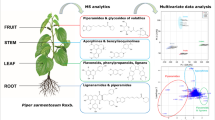Abstract
Isomeris arborea (Capparaceae), is the only woody caper endemic to southern California and northern Baja. Methylglucosinolate, also known as glucocapparin, was the only glucosinolate found inI. arborea organs by paper chromatography of the thiourea derivatives and was quantitatively determined by gas chromatography by hydrolytic products. The concentration of glucocapparin ranged from an average of 4.6 mg/g wet weight in mature leaves to 5.2 mg/g wet weight in immature leaves. Buds averaged 6.2 mg/g wet weight and capsule walls 1.8 mg/g wet weight. Seeds contained an average of 14.3 mg/g wet weight of glucocapparin. Glucocapparin concentration was found to vary significantly among the mature leaves of individuals within a single population. This compound is known to be deleterious to nonadapted herbivores and may be implicated in the chemical defense mechanism ofI. arborea.
Similar content being viewed by others
References
Cole, R.A. 1976. Isothiocyanates, nitriles, and thiocyanates as products of autolysis of glucosinolates in Cruciferae,Phytochemistry 15:759–762.
Daxenbichler, M.E., andVan Etten, C.H. 1977. Glucosinolates and derived products in cruciferous vegetables: Gas-liquid chromatographic determination of the aglucon derivatives from cabbage.J. Assoc. Off. Agric. Chem. 60:950–953.
English, K.J. 1983. Development and mortality ofMurgantia histrionica in relation to food quality. MS thesis. San Diego State University, p. 84.
Erickson, J.M., andFeeny, P. 1974. Sinigrin: A chemical barrier to the black swallowtail butterfly,Papilio polyxenes.Ecology 55:103–111.
Feeny, P. 1976. Plant apparency and chemical defense.Recent Adv. Phytochem. 10:1–39.
Feeny, P. 1977. Defensive ecology of the Cruciferae.Ann. Mo. Bot. Gard. 64:221–234.
Feeny, P., Paauwee, K.L., andDemong, J.J. 1970. Flea beetles and mustard oils: Host plant specificity ofPhyllotreta cruciferae andP. striolata adults (Coleoptera: Chrysomelidae).Annu. Rev. Entomol. Soc. Am. 63:832–841.
Freeman, G.G., andMossadeghi, N. 1972. Studies on sulfur nutrition and flavor production in watercress (Rorippa nasturtium-aquaticum (L) Hayek)J. Honic. Sci. 47:375–387.
Freeman, G.G., andMossadeghi, N. 1973. Studies on relationship between water regime and flavour stength in watercress (Rorippa nasturtium-aquaticum (L) Hayek), cabbage (Brassica oleracea capitata) and onion (Allium opa).J. Hortic. Sci. 48:365–378.
Gil, V., andMacLeod, A.J. 1980. Benzylglucosinolate degradationinLepidium sativum: Effects of plant age and time of autolysis.Phytochemistry 19:1365–1368.
Gmelin, R., andKjaer, A. 1970. Glucosinolates of nine Cruciferae and two Capparaceae species.Phytochemistry 10:2355–2358.
Iltis, H.H. 1957. Studies in the Capparidaceae. III. Evolution and phylogeny of the west American Cleomoidae.Ann. Mo. Bot. Gard. 44:77–119.
Josefsson, E. 1970. Glucosinolate content and amino acid composition of rapeseed (Brassica napus) meal as affected by sulfur and nitrogen nutrition.J. Sci. Food Agric. 21:98–103.
Ju, H.C., Chong, C., Bible, B., andMullin, W. 1980. Seasonal variation in glucosinolate composition of rutabaga and turnip.Can. J. Plant Sci. 60:1295–1302.
Kjaer, A., andSchuster, A. 1971. Glucosinolates inCapparis flexuosa of Jamaican origin.Phytochemistry 10:3155–3160.
Kjaer, A., andThomson, H. 1963. Isothiocyanate-producing glucosides in species of Capparidaceae.Phytochemistry 2:29–32.
Louda, S.M.,Farris, M., andBlua, M.J. 1985. Glucocapparin variation and insect damage toCleome serrulata (Capparaceae) along a soil moisture gradient.J. Chem. Ecol. In press.
MacLeod, A.J. 1976. Volatile flavour compounds of the Cruciferae, pp. 307–330,in J.G. Vaughen, A.J. MacLeod, and B.M.G. Jones (eds.). The Biology and Chemistry of the Cruciferae. Academic Press, London.
MacLeod, A.J., andMacLeod, G. 1977. Synthesis and natural occurance of 8-methylthiooctanonitrile and 9-methylthiononanonitrile.Phytochemistry 16:907–909.
McKey, D. 1974. Adaptive patterns in alkaloid physiology.Am. Nat. 108:305–320.
Nuss, C. 1983. Feeding behavior and within-host feeding preferences of the harlequin bug,Margantia histrionica, on the bladderpod plant,Isomeris arborea. MS thesis. San Diego State University. 65 pp.
Olsen, O., andSorensen, H. 1979. Isolation of glucosinolates and the identification ofO-(α-L-rhamnopyranosyloxy) benzylglucosinolate fromReseda odorata.Phytochemistry 18:1547–1552.
Rhoades, D.F. 1979. Evolution of plant chemical defense against herbivores, pp. 3–54,in G.A. Rosenthal and D.H. Janzen (eds.). Herbivores, Their Interaction with Secondary Plant Metabolites. Academic Press, New York.
Rhoades, D.F., andCates, R.G. 1976. Towards a general theory of plant antiherbivore chemistry.Recent Adv. Phytochem. 10:168–213.
Rodman, J.E. 1978. Glucosinolates, methods of analysis and some chemo-systematic problems.Phytochem. Bull. 11:6–31.
Schoonhaven, L.M. 1972. Secondary plant substances and insects.Recent Adv. Phytochem. 5:197–224.
Stoessl, A. 1970. Antifungal compounds produced by higher plants.Recent. Adv. Phytochem. 3:143–171.
Van Etten, C.H., andDaxenbichler, M.E. 1977. Natural poisons. Glucosinolates and derived products in cruciferous vegetables: Total glucosinolate by retention on anion exchange resin and enzymatic hydrolysis to measure released glucose.J. Assoc. Off. Agric. Chem. 60:946–949.
Van Etten, C.H., andTookey, H.L. 1979. Chemistry and the biological effects of glucosinolates, pp. 471–500,in G.A. Rosenthal and D.H. Janzen (eds.). Herbivores: Their Interaction with Secondary Plant Metabolites. Academic Press, New York.
Van Etten, C.H., Daxenbichler, M.E., Williams, P.H. andKwolek, W.F. 1976. Glucosinolates and derived products in cruciferous vegetables. Analysis of the edible part from twenty-two varieties of cabbage.J. Agric. Food Chem. 24:452–455.
Van Etten, C.H., Daxenbichler, M.E., Keudek, W.F., andWilliams, P.H. 1979. Distribution of glucosinolates in the pith, cambrialcortex, and leaves of the head in cabbage,Brassicae oleraceae L. J. Agric. Food Chem. 27:648–650.
Youngs, C.G., andWetter, L.R. 1967. Microdetermination of the major individual isothiocya-nates and oxazolidinethiones in rapeseed.J. Am. Oil Chem. Soc. 44:551–554.
Author information
Authors and Affiliations
Rights and permissions
About this article
Cite this article
Blua, M.J., Hanscom, Z. Isolation and characterization of glucocapparin inIsomeris arborea nutt. J Chem Ecol 12, 1449–1458 (1986). https://doi.org/10.1007/BF01012363
Received:
Accepted:
Issue Date:
DOI: https://doi.org/10.1007/BF01012363




